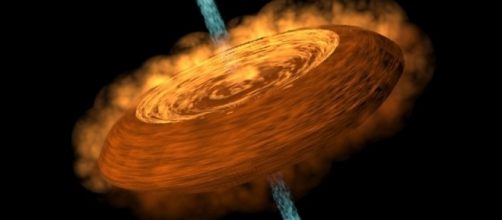In addition to the recent string of space news, scientists have made a new discovery as they located what is being described as a "space hamburger" deep inside the Orion Nebula. Scientists at the European Space Agency (ESA) are issuing a warning about Space Debris due to launching tiny satellites.
What is this space hamburger?
The space hamburger is actually an accretion disk, which is a cloud of dust and gas that rotates around whatever its central point is. The space hamburger's central point is a young protostar, located deep inside the Orion Nebula that is feeding on the space hamburger.
The discovery of an accretion disk is nothing new for astronomers, as they have seen them before around stars or black holes. However, this is the first one found with such a unique shape.
The discovery was made using the new Atacama Large Millimeter/submillimeter Array (ALMA) in Chile. For the first time it also confirmed scientist's theory that these accretion disks can form in the early phases of a star's life. Scientists also got a very detailed view of the structure and hope that this discovery can help them learn more about how new planets form.
A warning about tiny satellites ruining space
The European Space Agency (ESA) is issuing a warning about the current state of space debris in low Earth orbit and how it could potentially become much worse in the future.
They are warning that the problem could get worse with the rise of cheaper and tinier satellites being launched into orbit in unprecedented numbers. The ESA gave their warning through a short film "Space Debris: A Journey to Earth" at this years European Conference on Space Debris.
According to a 2013 report on space debris from NASA, there are more than 500,000 pieces of space debris in orbit around Earth. All of these are potentially dangerous, as paint flecks can take out windows on a space shuttle. This was predicted by NASA's Donald Kessler, who spoke at the conference back in the 1970s. His theory, called Kessler Syndrome, said that objects in low Earth orbiting hit each other at high speeds and explode into smaller pieces.
These pieces would then hit more objects, which could all lead to the worst case scenario where there is a giant, unstoppable, chain-reaction traffic wreck in low Earth orbit.
Despite these warnings, more and more satellites are being launched into space. In February, India launched 104 tiny satellites from a single rocket to set a world record. So far only about 7,000 spacecraft have left Earth in human history, but 12,000 are set to go up soon. A lot are going to be launched by companies like SpaceX or Samsung. Despite these newer nano-satellites being smaller, they lack navigation and there will be a lot of them. With voluntary guidelines to remove dead satellites out of orbit ignored, Earth's orbit could become a nightmare in the future.

